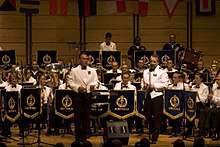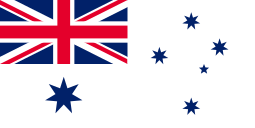Royal Australian Navy Band
The Royal Australian Navy Band (RAN Band) is the Royal Australian Navy's official musical branch. The band comprises two full-time detachments and four part-time detachments positioned across Australia, and is one of the few platforms in which Navy can deliver its message to the people of Australia. The current director of music is Lieutenant Commander Steven Stanke.
| Royal Australian Navy Band | |
|---|---|
 | |
| Active | 1913 |
| Country | |
| Branch | Royal Australian Navy |
| Size | 101 full time members |
| Garrison/HQ | Sydney |
| Motto(s) | Serving in Harmony |
| Commanders | |
| Current commander | Lieutenant Commander Steven Stanke |
| Insignia | |
| Naval Ensign (1967–present) |  |
| Abbreviation | RAN Band |
History
In 1893, the New South Wales Naval Brigade Band comprised 22 personnel. Another of the very early naval bands was the Band of the Victorian Naval Brigade which was present (as a band of the Commonwealth Naval Force in 1901) at the arrival of the US Navy's "Great White Fleet" into Port Phillip Bay in 1908.
On 10 July 1911, King George V gave the Commonwealth Naval Forces the name of Royal Australian Navy.
On 21 June 1913, six musicians (recruited in Melbourne) were sent to the United Kingdom to join up with a number of ex-bandsmen from the British Navy to form the Royal Australian Navy Band. The members of the band returned to Sydney on 4 October 1913.
During WWII, the Korean War and the Vietnam War, musicians of the band performed at concerts for Australian troops.
Composition

Detachments
The different detachments of the band include:
- RAN Band Melbourne (full-time)
- RAN Band Queensland (part-time)
- RAN Band South Australia
- RAN Band Sydney (full-time)
- RAN Band Tasmania (part-time)
- RAN Band Western Australia (part-time)
Ceremonial Drums
The Ceremonial Drums of the RAN Band were commissioned by the Government of Australia on July 10, 1961 to mark the 50th anniversary of the band's naming. The set consists of eight side drums, two tenor drums and one bass drum.
Repertoire
The repertoire of the RAN Band includes but is not limited to:
- Serving in Harmony
- Duke of York
- On The Quarterdeck
- March of the Royal Australian Navy
- Scipio
- The Middy
- Waltzing Matilda
- Abide With Me
- Amazing Grace
- Crimond
- Deep Harmony
- Eternal Father
- O God Our Help
- Advance Australia Fair
- God Save The Queen
References
External links
| Wikimedia Commons has media related to Royal Australian Navy Band. |